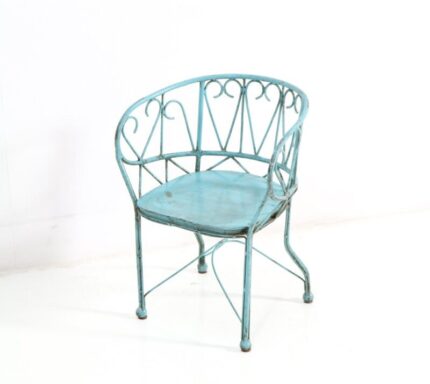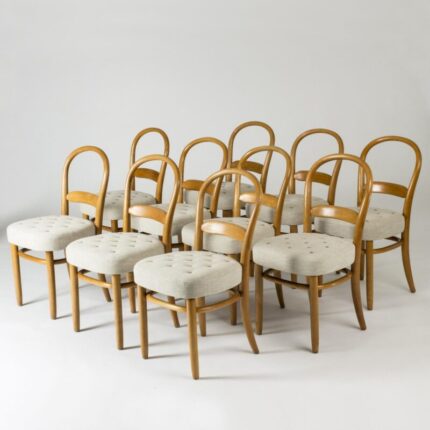Vintage Design
A fine Victorian Louis XVI style burr walnut and purplewood breakfront wardrobe attributed to Holland & Sons, circa 1860 in date. The wardrobe is applied with gilt bronze mounts throughout and features a shaped moulded cornice with four turned finials and a riband tied swagged frieze, above a central bevelled mirrored door which opens to reveal three slides, three short and two long drawers. Flanked on either side by a pair of panelled cupboard doors each enclosing a rail and hooks. Beautifully framed by reeded pilasters, on a moulded plinth base. The wardrobe offered here undoubtedly formed part of a significant commission of bedroom furniture of high quality for a client who currently remains untraced. The presence of a 1929 storage label for The Pantechnicon, Belgrave Square, S.W.1 which bears the inscribed name R.B Petre would seem likely to indicate that it was handled by R.B Petre in his capacity as a prominent liquidator in early 20th century London. Petre’s name has been recorded in contemporary newspaper advertising as instructing various sales of property by auction. The above lot is typical of the high quality work produced in the Louis XVI style that Holland and Sons produced in the 1860s and 1870s. The ormolu mounts utilised on the above lot appear on documented pieces by the firm including the well known commission in the 1860s by Mr R N Thornton, illustrated in R.W Symonds, B.B Whineray Victorian Furniture, London 1962. Under William Holland the firm became cabinet makers and upholsterers to the Queen, their first commission being for Osborne House in 1845, supplying furniture in the Queen’s favoured Louis XVI style. Hollands participated in many of the important International Exhibitions including London in 1862, Vienna in 1873 and Paris in 1867 and 1872 again exhibiting pieces in the favoured Louis XVI style. The Holland’s labelled day books are now housed in the National Archive of Art and Design in London and present a virtual ‘who’s who’ of 19th century society. There is no mistaking its unique quality and design, which is certain to make it a talking point in your home. As such, this card table is sure to take pride of place in your lounge or reception. Condition: In excellent condition. As antique items, the wardrobe show signs of use commensurate with age, these minor condition issues are mentioned for accuracy and, as seen in the accompanying photographs, it displays beautifully. Dimensions in cm: Height 273 x Width 269 x Depth 77 Dimensions in inches: Height 8 foot, 11 inches x Width 8 foot, 10 inches x Depth 2 foot, 6 inches. Holland & Sons The firm of Holland & Sons (1803–1942) became from 1843 one of the largest and most successful cabinet makers, and a rival to Gillows of Lancaster and London. The company’s labelled Day books are now housed in the Victoria and Albert Museum Archive of Art and Design where they present a virtual ‘who’s who’ of nineteenth century society. Established in 1803 by Stephen Taprell and William Holland, a relation of the architect Henry Holland (architect). Always on the leading edge of fashion, Holland & Sons employed some of England’s foremost designers and participated in all of the International Exhibitions of 1851, 1855, 1862, 1867, 1872 and 1878. Holland and Sons also participated in many of the leading international exhibitions including London in 1862, Vienna in 1873 and Paris in 1867 and 1872. After a brief period in which the company was known as Taprell, Holland & Son c.1835-43, William Holland gained sole command after the senior partner Taprell’s retirement. From 1843 onwards they were known as Holland and Sons. The relationship between builder and cabinet maker is similar to another leading Victorian firm, Trollope and Sons. Their earliest known commission was to furnish the Athenaeum Club, London, 1824- 1838. They also worked alongside the prestigious firm of Thomas Dowbiggin at Osborne House, and eventually took over their premises and business at 23 Mount Street, London in 1851 and 1853 respectively. In 1851, when the company was based in Mount Street and employed 351 people, they won a prize at the Great Exhibition for a bookcase. By then, after being granted a Royal Warrant of Appointment (United Kingdom) early in the reign of Queen Victoria, they had already taken a leading part in the decoration and furnishing of Osborne House, Sandringham House, Balmoral Castle, Windsor Castle and the apartments of the Prince and Princess of Wales at Marlborough House, executing numerous exceptional pieces of furniture. Holland and Sons also executed over three hundred separate commissions for the British Government, including the Palace of Westminster, the Victoria and Albert Museum, and oversaw the State funeral of Arthur Wellesley, 1st Duke of Wellington. One of their celebrated private commissions was a suite of bedroom furniture for the late Sir Harold Augustus Wernher, 3rd Baronet at Luton Hoo. During the latter half of the 19th century, Holland and Sons also supplied furniture for such notable London clubs as the Reform Club and the Oxford and Cambridge Club. Along with Gillows they shared the commission for the new Palace of Westminster. Walnut & Burr Walnut Walnut is a hard, dense, tight- grained wood that polishes to a very smooth finish. It is a popular and attractive wood whose colour ranges from near white in the sapwood to a dark hew in the heartwood. When dried in a kiln, walnut wood tends to develop a dull brown colour, but when air-dried can become a rich purplish-brown. Because of its colour, hardness and grain, it is a prized furniture and carving wood. Walnut veneer was highly priced and the cost would reflect the ‘fanciness’ of the veneer – the more decorative, then the more expensive and desirable. Burr walnut refers to the swirling figure present in nearly all walnut when cut and polished, and especially in the wood taken from the base of the tree where it joins the roots. However the true burr is a rare growth on the tree where hundreds of tiny branches have started to grow. Burr walnut produces some of the most complex and beautiful figuring you can find. Walnut “burrs” were often used to make fabulous furniture. Veneer sliced from walnut burl is one of the most valuable and highly prized by cabinet makers and prestige car manufacturers and is also a favourite material for shotgun stocks.
| Production Period | Before 1890 |
|---|---|
| Style | Antique |
| Detailed Condition | |
| Product Code | SQL-1258331 |
| Materials | Walnut |
| Color | Brown |
| Width |
269 cm 105.9 inch |
| Depth |
77 cm 30.3 inch |
| Height |
273 cm 107.5 inch |
| Duties Notice | Import duty is not included in the prices you see online. You may have to pay import duties upon receipt of your order. |



























































Reviews
There are no reviews yet.